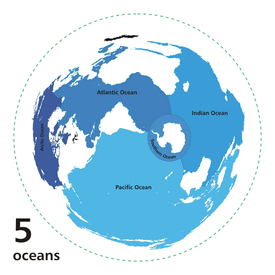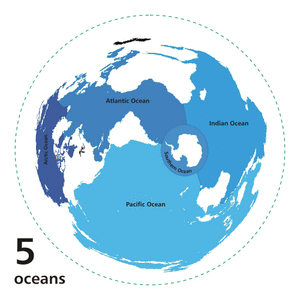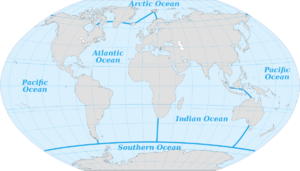World Ocean facts for kids
| Earth's ocean |
|---|
|
Main five oceans division: Further subdivision: Marginal seas |
The World Ocean, also called the global ocean, is a term that describes all the Earth's oceans as one giant, connected body of water. Imagine all the oceans flowing into each other without any real borders. That's the World Ocean!
It's usually divided into five main parts: the Atlantic Ocean, Arctic Ocean, Indian Ocean, Pacific Ocean, and the Southern Ocean. The Southern Ocean is the one that circles Antarctica.
The World Ocean is often thought of as being centered around the southern parts. You can think of the Atlantic, Indian, and Pacific Oceans as large "arms" or "lobes" that stretch northward from the Southern Ocean. Further north, the Atlantic connects to the Arctic Ocean. The Arctic Ocean then links to the Pacific Ocean through a narrow passage called the Bering Strait.
Contents
The Five Main Oceans
The Southern Ocean
The Southern Ocean surrounds Antarctica, the icy continent at the bottom of the world. It generally includes all the ocean south of 60 degrees south latitude. Parts of this ocean are covered in sea ice, which is frozen seawater. The amount of ice changes with the seasons. The Southern Ocean is the second smallest of the five named oceans.
The Atlantic Ocean
The Atlantic Ocean is the second largest ocean. It stretches from the Southern Ocean all the way up to the Arctic Ocean. It's located between South America, Africa, North America, and Europe. The Atlantic Ocean meets the Indian Ocean south of Africa, near a place called Cape Agulhas.
The Indian Ocean
The Indian Ocean extends northward from the Southern Ocean towards India. It lies between Africa and Australia. To the west, near Australia, the Indian Ocean connects with the Pacific Ocean.
The Pacific Ocean
The Pacific Ocean is the biggest ocean on Earth! It also reaches northward from the Southern Ocean up to the Arctic Ocean. It fills the huge space between Australia, Asia, North America, and Oceania. The Pacific Ocean meets the Atlantic Ocean south of South America, at a famous spot called Cape Horn.
The Arctic Ocean
The Arctic Ocean is the smallest of the five oceans. It connects to the Atlantic Ocean near Greenland and Iceland. It also joins the Pacific Ocean at the Bering Strait. This ocean is located at the North Pole, touching North America in the Western hemisphere and Scandinavia and Asia in the Eastern hemisphere. Like the Southern Ocean, parts of the Arctic Ocean are covered in sea ice that changes with the seasons. Some people think the Arctic Ocean is more like a large sea of the Atlantic because it's mostly surrounded by land and doesn't exchange much water with other oceans. They sometimes call it the Arctic Mediterranean Sea or Arctic Sea.
How Oceans Change
The overall shape of the World Ocean usually stays the same. However, it does change over time. Climate change can slowly alter its structure, for example, by affecting sea levels and ice. Over much longer periods, like millions of years, continental drift also changes the shape of the oceans as continents move around the Earth.
Related Pages
See also
 In Spanish: Océano mundial para niños
In Spanish: Océano mundial para niños





